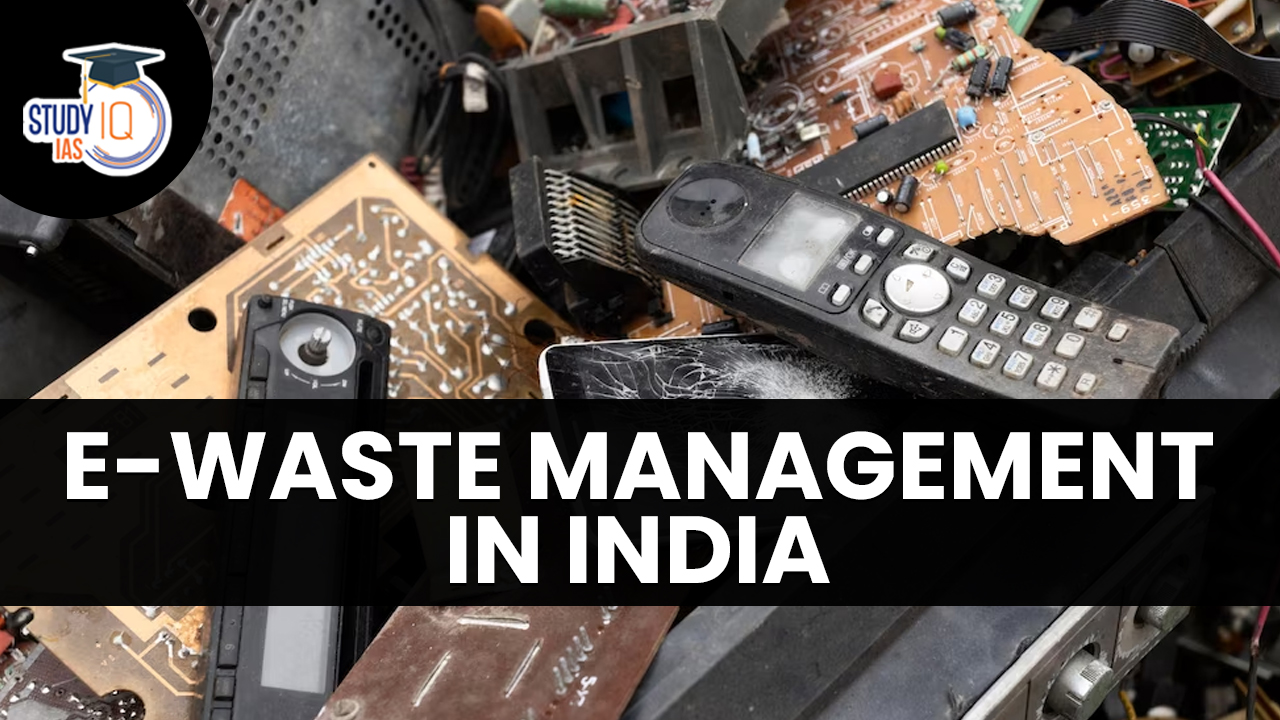Table of Contents
Context: With the rapid digital transformation in India need to manage its e-waste.
What is E-waste?
- E-waste is a term used to cover items of all types of electrical and electronic equipment (EEE) and its parts that have been discarded by the owner as waste without the intention of re-use.
- E-waste can be generated from various sources, including households, businesses, and industries, and it poses significant environmental and health challenges when not properly managed.
Concerns with E-waste
- Environmental Pollution: E-waste often contains hazardous materials like lead, mercury, cadmium, and brominated flame retardants. Improper disposal can result in the leaching of these substances, leading to soil and water pollution.
- Health Risks: Exposure to e-waste can cause headaches, irritability, nausea, vomiting, and eye pain. Recyclers may suffer from liver, kidney, and neurological disorders.
Current Volume of E-waste
India
- Massive Increase in E-waste: India’s e-waste generation rose 03% in 6 years — from 7.08 lakh metric tonnes (MT) in 2017–18 to 17.78 lakh MT in 2023–24.
- Global Rank: India is one of the top 5 e-waste generators, behind China, the US, Japan, and Germany.
- Informal Sector Dominance: Around 95% of e-waste is handled by the informal sector, using crude, hazardous methods.
- Poor Formal Recycling: Only ~10% of e-waste reaches formal recycling facilities.
Global
- Mounting E-waste: The world generated 4 million tonnes of e-waste in 2021 and is projected to exceed 74 million tonnes by 2030.
- Low Recycling Rate: Only ~17.4% of global e-waste is officially collected and recycled.
- Precious Resource Loss: E-waste contains valuable metals (gold, copper, rare earths), but poor recycling means billions of dollars are lost annually.
Status of E-waste
| Status of E-waste in India | Global Status of E-waste |
|
|
Why India Must Urgently Manage its E-waste
- Environmental Risks: E-waste contains hazardous materials like lead, mercury, cadmium, and flame retardants.
- Improper disposal leads to air, water, and soil pollution, affecting ecosystems and human health.
- Public Health Crisis: Informal processing often employs women and children, exposing them to toxic chemicals.
- Average lifespan of workers in this sector is reportedly less than 27 years.
- Economic Losses: India loses:
- $10 billion annually in environmental damage (pollution).
- ₹80,000 crore+ annually in critical metal value due to inefficient recycling.
- $20 billion+ annually in unaccounted tax revenue from informal operations.
- Missed Opportunities: E-waste is a potential goldmine for resource recovery and the circular economy.
- Formal recycling could create green jobs, stimulate technological innovation, and reduce dependency on rare materials.
Several Concerns with E-waste Management in India
- Lack of infrastructure: There is a huge gap between the present recycling and collection facilities and the quantum of e-waste that is being generated.
- Lack of private participation: E-waste recycling is a relatively new business, and the potential lack of information on cost-effective recycling technologies acts as a market barrier.
- Lack of Awareness and Financial Incentives: Consumers lack market information about prices for e-waste and various e-waste components, and they have few financial incentives for responsibly disposing of their e-waste.
- Involvement of child labour: In India, about 4.5 lakh child labourers are observed to be engaged in various e-waste activities and that too without adequate protection.
E-waste Management Rules 2022
Notified by the Ministry of Environment, Forest and Climate Change (MoEF&CC), in the exercise of the powers conferred by the Environment (Protection) Act, 1986. Key provisions of the rules include:
- Definition: ‘E-waste’ means electrical and electronic equipment, whole or in part, discarded as waste, as well as rejects from manufacturing, refurbishment and repair processes.
- Application: These rules shall apply to every manufacturer, producer, refurbisher, dismantler, and recycler involved processing of e-waste with certain exceptions.
- Responsibilities:
- Manufacturers:
- Make the end product recyclable.
- Components made by different manufacturers should be compatible with each other.
- Producers:
- Obtaining and implementing extended producer responsibility targets (at least 60% of their electronic waste is collected and recycled by 2023 with increasing them to 70 and 80 percent in 2024 and 2025, respectively).
- Creating awareness.
- Recycler:
- Ensuring that the recycling processes and facilities are by the regulatory standards.
- Maintain a record of e-waste collected.
- State government:
- They have to earmark space for e-waste dismantling and recycling in the existing and upcoming industrial parks, estates, and industrial clusters.
- Undertaking industrial skill development and establishing measures for protecting the health and safety of workers engaged in the dismantling and recycling facilities for e-waste.
- Manufacturers:
- Registration: The manufacturer, producer, refurbisher, or recycler of the e-products needs to compulsorily register with the Central Pollution Control Board (CPCB).
- Extended Producer Responsibility Certificates: Rules aim to incentivise registered electronic waste recyclers by introducing Extended Producer Responsibility (EPR) certificates (which were not part of the 2016 Rules).
- EPR means the responsibility of any producer of electrical or electronic equipment for meeting recycling targets to ensure environmentally sound management of e-waste.
- Monitoring: CPCB shall conduct random sampling of electrical and electronic equipment placed on the market to monitor and verify compliance with the reduction of hazardous substances provisions.
- Environmental Compensation: CPCB shall also lay down guidelines for the imposition and collection of environmental compensation on the producer in case of non-fulfilment of obligations.
E-waste Management Amendment Rules, 2023
- This amendment adds two substances to the exemptions listed in Schedule II of the E-waste (management) Rules 2022 as follows:
- Cadmium and lead in Solar panels/cells, solar Photovoltaic panels/cells/ modules.
- Lead in Medical Devices (except all implanted and infected products).
- Every producer shall provide detailed information on the constituents of the equipment and their components or consumables or parts, or spares.
- This information would be provided along with a declaration of conformance to the reduction of hazardous substances provisions as and when required by the Central Pollution Control Board.
What Needs to Be Done
- Strengthen Extended Producer Responsibility (EPR): Enforce strict EPR targets for producers, importers, and brand owners.
- Expand the list of covered products beyond IT and telecom to include household electronics, EV batteries, etc.
- Implement Floor Pricing for EPR Certificates: Ensure fair compensation to formal recyclers to counter the cost advantage of the informal sector.
- Encourage investment in safe, advanced recycling technologies.
- Formalise and Regulate the Informal Sector: Integrate informal workers into formal systems via training, certification, and safety standards.
- Provide financial and policy incentives for informal recyclers to transition.
- Expand Infrastructure and Capacity: Set up more formal recycling facilities with regional access.
- Provide low-cost financing, tech transfer, and public-private partnerships for infrastructure development.
- Raise Public Awareness: Launch nationwide campaigns on safe disposal and take-back programs.
- Encourage consumer responsibility and participation in buy-back schemes.
- Create a National E-waste Monitoring System: Use digital platforms and AI tools for real-time tracking of e-waste generation, collection, and recycling.
- Improve data transparency and inter-agency coordination.
Conclusion
India’s digital rise must not come at the cost of environmental collapse. A robust e-waste management framework — built on EPR reforms, pricing stability, infrastructure, and integration of informal workers — is essential. With the right policies and public support, India can turn its e-waste crisis into an opportunity for green growth and global leadership in sustainable innovation.


 Indian Rhinoceros, Conservation, Threats...
Indian Rhinoceros, Conservation, Threats...
 Marlin Fish: Species, Features, Appearan...
Marlin Fish: Species, Features, Appearan...
 Great Hornbill (Buceros bicornis): Habit...
Great Hornbill (Buceros bicornis): Habit...





















